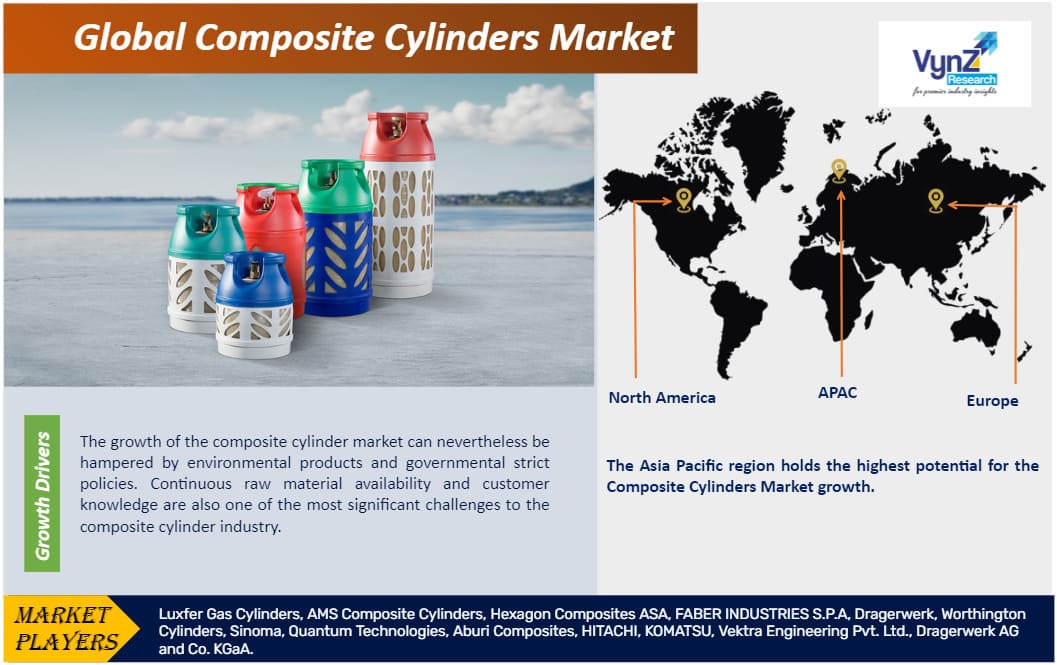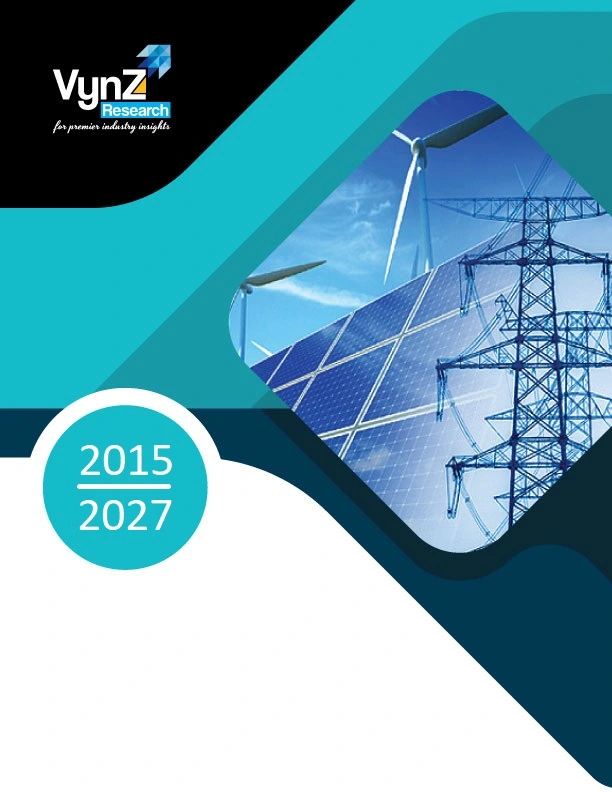Industry Overview
The world market size for Composite Cylinders will hit USD 1.04 billion by 2030, from USD 0.69 billion by 2023 and 6.6% by CAGR between 2025 and 2030.

Thanks to their unique properties such as being lightweight and not corrosive, composite cylinders are used more and more in developed and developing countries. Furthermore, they can be used as an alternative to steel cylinders. This reduces the cost of production and increases the company's sales growth. As a result, many producer investments in the composite cylinder industry have been gradually growing. Furthermore, the composite polymers are UV-safe, non-corrosive and explosion-proof. Due to this, the demand for gas and oil products is rising, these stain-proof and translucent properties help measure or suggest gas in the cylinder. Furthermore, these cylinders can be transported easily because they are lightweight. This aspect also contributes to reducing transport costs.
Composite LPG cylinders composed and attached with resin are composed of helically woven fiber. They represent a significant shift to a new generation technology that has desirable characteristics, including 100% recyclable and UV-resistant characteristics, to name a few.
Composite cylinders on the safety front boast not to be explosive, even if engulfed in flames. The composite solution is unusual in that the composition is transparent and allows for an easy visibility in the previously impossible LP gas levels, in addition to being fifty percent lighter than traditional stainless-steel cylinders.
The growth of the composite cylinder market can nevertheless be hampered by environmental products and governmental strict policies. Continuous raw material availability and customer knowledge are also one of the most significant challenges to the composite cylinder industry. Due to increased demand from the packaging and electronics industry, the composite cylinder external casing material segment is expected to develop strongly over the forecast period. Due to its lightweight and energy-saving applications, such as electronics transportation, wooden materials, or other items, the growing application of composite cylinder systems has been having a positive effect.
The size of the demand for composite cylinders is expected to rise significantly from 2025 to 2030. The composite cylinders will be expanding with the rising demand for lightweight storage solutions combined with the growing amount of natural gas vehicles. The industry landscape would be increased by continuous urbanization along with an increasingly increasing population.
The growing transport industry, combined with the strict safety requirements for safe gas transport, would drive the market share of the composite cylinders. The growing adoption and easy handling of the product would improve the market landscape due to its explosion-bearing ability. The composite cylinder consists of a transparent structure that allows the consumer to see the amount of gas clearly.
These cylinders are commonly used in different industries, including help for life, leisure industries, and other industries. Moreover, strict environmental policies for the manufacture of these cylinders would hurt the growth of the company. In the manufacturing process, however, recycled material is used to minimize the cost of the product and its effect on the environment. Due to growing R&D efforts and favorable government rules to encourage LPG adoption, the composite cylinders market is expected to expand.
Market Segmentation of Global Composite Cylinder
By Outer Casing Material
- Glass Fibers
- Carbon Fibers
- High Density Polyethylene
- Other (medical, aerospace, marine, and defense)
The high-density polyethylene group was one of the most important outdoor casing materials and is projected in the coming years to remain the largest category. The rise in the category of high-density polyethylene is primarily based on its lightweight features and higher performance benefits.
By Tank Type
- Type I
- Type II
- Type III
- Type IV
Based on type III and type IV cylinders, the global LPG composite market is segmented. Type IV is the most common type of cylinder on the LPG composite market. During the forecast era, the cylinder type is expected to be greater and faster to develop. All the main composite manufacturers of LPG cylinders are only present in type IV tanks. The Cylinders Type IV provides the highest weight reduction and increased explosive pressure in contrast to the cylinders Type I and Type III.
By End Use Industry
- Household Purpose
- Hotels and Restaurants
- Industrial Fuel
- Industrial Process
- Automotive
The global composite cylinder market will be powered by an expansion in the household segment. Composite cylinder is commonly used in homes and hotels for cooking purposes. They are commonly used in hospitals, naval, chemical, and spacecraft as oxygen cylinders. Oxygen, nitrogen, and hydrogen cylinders are also used in the chemical industry in reactions of chemical processing. CNG cylinders are widely used as fuel for automobiles in the automotive industry. Composite cylinders are commonly used for scuba diving because they are lighter in weight.
By Region
- North America
- Europe
- Asia-Pacific
- Rest of the World
Regional research in North America, Europe, Asia Pacific, and the Rest of the World of the worldwide composite cylinder industry is split. Asia Pacific is one of Composite Cylinder's fastest-growing markets by area. An increasing chemical and packaging industry in different developing and developed countries is likely to boost demand for composite cylinders. Other driving forces in the Asia Pacific world of composite cylinders include a greater understanding of composite cylinders and rapid industrialization in developing economies. Moreover, North America is estimated to have a significant share of the world market for composite cylinders because of its high per-capita consumption of goods.
Global Composite Cylinders Market Report Coverage
|
Report Metric
|
Details
|
|
Historical Period
|
2018 - 2023
|
|
Base Year Considered
|
2024
|
|
Forecast Period
|
2025 - 2030
|
|
Market Size in 2024
|
U.S.D. 0.69 Billion
|
|
Revenue Forecast in 2030
|
U.S.D. 1.04 Billion
|
|
Growth Rate
|
6.6%
|
|
Segments Covered in the Report
|
By Tank Type, By Outer Casing Material, By End Use Industry
|
|
Report Scope
|
Market Trends, Drivers, and Restraints; Revenue Estimation and Forecast; Segmentation Analysis; Impact of COVID-19; Companies’ Strategic Developments; Market Share Analysis of Key Players; Company Profiling
|
|
Regions Covered in the Report
|
North America, Europe, Asia-Pacific, Middle East, and Rest of the World
|
Competitive Landscape and Key Players of the Global Composite Cylinder Market
Advanced Material Systems, is a leading designer and manufacturer of composite products based in Taiwan. The company focuses on the design and mass production of composite pressure cylinders for a variety of applications. The strength of the company is in combining a strong R&D knowledge with extensive experience in mass production.
Hexagon Composites ASA is a world leading composite cylinder technology enables the safe delivery of clean gaseous energy to homes and industries - and decarbonizes transportation on land and at sea. There are thousands of solutions and six decades of experience helping our customers reduce CO2 emissions.
- Luxfer Gas Cylinders
- AMS Composite Cylinders
- Hexagon Composites ASA
- FABER INDUSTRIES S.P.A
- Dragerwerk
- Worthington Cylinders
- Sinoma
- Quantum Technologies
- Aburi Composites
- HITACHI
- KOMATSU
- Vektra Engineering Pvt. Ltd.
- Dragerwerk AG and Co. KGaA.
There is a very large concentration in the global composite cylinder industry. Luxfer Gas Cylinder, Hexagon Composites, Aburi Composites, Faber Industry, and Worthington Cylinders are all leading producers in North America and Europe.
News Update for Global Composite Cylinders Market
National Gas and Industrial Company (Gasco) and Hexagon Composites' subsidiary Hexagon Ragasco have signed a long-term distribution agreement. The five-year contract covers the provision and distribution of custom-made LPG cylinders on the Saudi Arabian domestic market.
Quantum Materials LLC has acquired Innegra Technologies’. Innegra will serve as a foundational product to support Quantum’s growth of technical and industrial textile solutions for the composites and textile markets.
Primary Research
VynZ Research conducts extensive primary research to understand the market dynamics, validate market data, and have key opinions from industry experts. The key profiles approached within the industry include, CEO, CFO, CTO, President, Vice President, Product Managers, Regional Heads, and Others. Also, end user surveys comprising of consumers are also conducted to understand consumer behavior.
The Composite Cylinders Market report offers a comprehensive market segmentation analysis along with an estimation for the forecast period 2025–2030.
- Tank Type
- Type I
- Type II
- Type III
- Type IV
- Outer Casing Material
- Glass Fibers
- Carbon Fibers
- High Density Polyethylene
- Others (medical, aerospace, marine, and defense)
- End Use Industry
- Household Purpose
- Hotels and Restaurants
- Industrial Fuel
- Industrial Process
- Automotive
Region Covered in the Report
- North America
- Europe
- Germany
- U.K.
- France
- Italy
- Spain
- Russia
- Rest of Europe
- Asia-Pacific (APAC)
- China
- Japan
- India
- South Korea
- Rest of Asia-Pacific
- Rest of the World (RoW)
- Brazil
- Saudi Arabia
- South Africa
- U.A.E.
- Other Countries
.png)
Source: VynZ Research
.png)
Source: VynZ Research




.png)
.png)